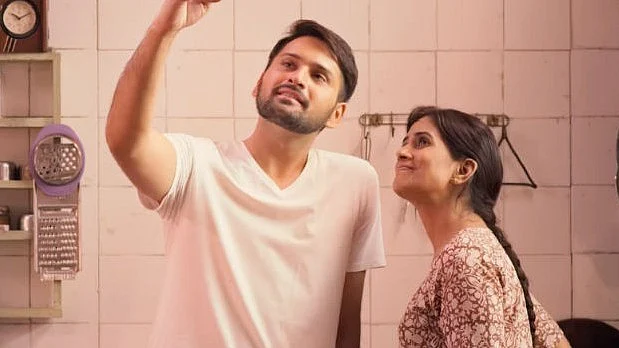My mother believed less and less in demonstrative love as I grew up but the comforting familiarity of some of the food she cooks continues to tether me to my past and invoke an invisible bond. Food has a way to make the most seemingly tenuous bonds thicker. Beyond flavour, it can rouse a sense of adventure and at the same time, bind us to our roots.
In Gulabjaam, when a London banker, Aditya digs into the titular dessert, he steps on a landmine of memories that agreeably explode. We see him taking a bite and being transported to his sepia-tinted childhood - an instant throwback to the idyllic idea of ‘home’.
The Sachin Kudalkar directorial sets the tone of this Marathi ‘food’ film with this idea of food as muscle memory. Kundalkar posits the notion of food holding the possibilities of healing old emotional wounds.
Aditya, a banker (Siddharth Chandekar) leaves behind his handsomely paid job in London to realise his long-held dream of learning authentic Maharashtrian cuisine to be able to start a restaurant serving traditional Maharashtrian fare in London. Tetchy Radha Agarkar (Sonali Kulkarni), who prepares ‘tiffin food’ in a neighbourhood in Pune, reluctantly makes him her student. This apprenticeship unravels both - the mentor and the mentee.
Maharashtrian Cuisine Is the Protagonist of Gulabjaam
Teeming with Proustian concepts, the film steers clear of flashy Instagram-esque visuals. The opening titles unfurl on a worn-out recipe book. Gulabjaam evokes a longing for traditional Maharashtrian cuisine in a moving, literary sense, hinting at the slow death of a way of life, deeply embedded in the mundane business of cooking and the sense of community it rouses. A dollop of ‘tuup’ (ghee/clarified butter) on varan bhat ( Maharashtrian version of Dal-rice), cardamom syrup-soaked gulab jamuns jostling for space in a bowl, crispy kothimbir vadis (coriander leaves fritters) - these humble delights appear unassumingly in a metal dish.
The film is not only preoccupied with the end result - the cooked meal but all that comes before and surrounds it. The dialogue is laced with metaphors about food. Radha points out to Aditya, in her ‘academic’ rigour about how cleaning up after the ‘feast’ is a part of learning to be a cook. The dialogue is laced with metaphors of food. In another exchange with, Radha disperses the uncomplicated yet weighty wisdom about the fragrance of food and what a whiff can do.
Barring one scene with fried fish, it does not spark a visceral gluttony like the Malayalam Angamaly Diaries, what with its context of local, vegetarian Puneri food but that will not deter your stomach from growling. Gulabjaam is not just about edible truths. Food is a prism through which the characters are observed. When Aditya talks to the ingredients of the meals he is about to whip up, he is actually breaking the fourth wall and confiding in the audience. For Radha, cooking is all about finding the best part of oneself and letting it seep into the meal being rustled up. It is the art of cookery that serves as her liberation and redemption after braving a traumatic past. It is this flair that finally helps her exorcise her psychological demons.
The leitmotif of food can be found in most of Aiyya director Kundalkar’s films - be it Restaurant (2006) or Vazandar (2016). But a male protagonist stubbornly passionate about learning traditional Maharashtrian cooking and going against his family’s wishes can easily be one of the firsts in Marathi cinema that is incessantly striving to tread new ground.
An unconventional conclusion saves the film from a predictable end when you think it’s swerving in a more formulaic direction.
Gulabjaam is not only a ‘food’ film but also a nostalgic nod to the city of Pune where many places look frozen in time - like the single screen Alka Theatre, where Radha feels at home. Kundalkar also seems to be tipping his hat to Ranbir Kapoor.
The Endearing Vulnerability & Quiet Strength of Radha
The turmoil belying the vulnerability that Sonali Kulkarni brings to the character makes Gulabjaam compelling. She gets a meaty backstory to sink her teeth into. Kulkarni even reportedly worked hard to modulate her voice and bring more ‘bass’ to it to slip into the skin of the character - Radha, who stretches a veneer of bluntness over her trauma and messy desires. A recluse, she finds solace in the suspended reality of films in a dark cinema hall.
Kulkarni even allegedly changed the setting of the house to make it look like an abode she would inhabit. Details like a single cup hanging on the kitchen shelf, a dusty and defunct landline next to a withered candle and modern gadgets conspicuous by their absence amplify her isolated existence.
Look out for the scene where Renuka Shahane appears briefly and shatters her tenacious exterior.
This Feast Will Whet Your Appetite
A scenario that stirs a primeval fear for yours truly is the fate of our culinary legacy that will die with our parents and grandparents, if we don’t venture into the kitchen to preserve some part of it.
This movie will make you dial your parent to commit to memory the recipe of one of your favourite childhood meals.
Be nourished by this comfort fare and feel the familiar tug of memories.
Statutory warning: If vegetarian food floats your boat, Gulabjaam will make you very hungry.
(At The Quint, we question everything. Play an active role in shaping our journalism by becoming a member today.)
